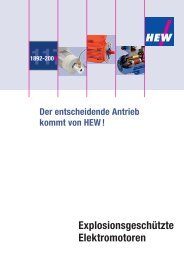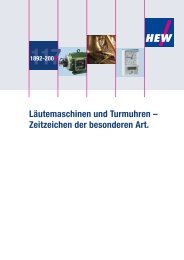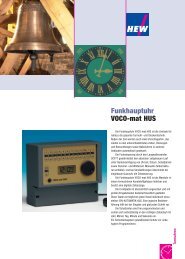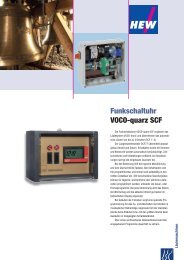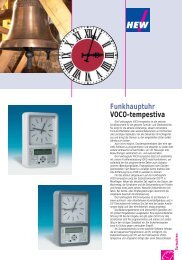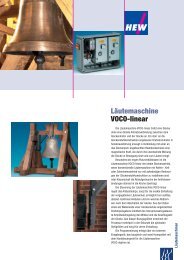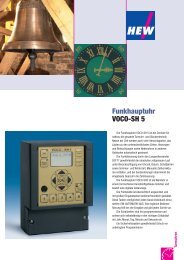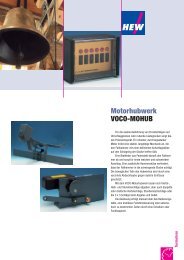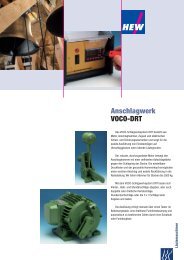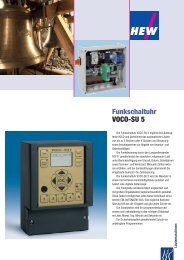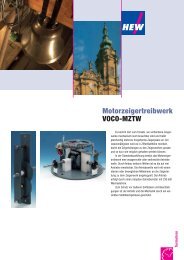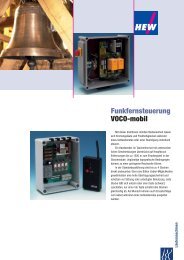Explosion-protected electric motors - Hew-hf.de
Explosion-protected electric motors - Hew-hf.de
Explosion-protected electric motors - Hew-hf.de
You also want an ePaper? Increase the reach of your titles
YUMPU automatically turns print PDFs into web optimized ePapers that Google loves.
Three-phase A.C. <strong>motors</strong><br />
Permitted use of <strong>motors</strong> as per marking, <strong>de</strong>pending on zone allocation<br />
Group Category Zone allocation Definition Certification<br />
obligation<br />
For combustible gasses, vapours and mist<br />
II 1G* 0 Zone 0 inclu<strong>de</strong>s areas in which an explosive atmosphere which<br />
arises constantly, long-term or frequently due to a mixture of air<br />
and gasses, vapours or mist.<br />
Yes<br />
II 2G 1 Zone 1 inclu<strong>de</strong>s areas in which an explosive atmosphere is expected<br />
to arise occasionaly due to gasses, vapours or mist.<br />
Yes<br />
II 3G 2 Zone 2 inclu<strong>de</strong>s areas in which an explosive atmosphere is not<br />
expected to arise from gasses, mists or vapours but if it does arise,<br />
it is likely to be rare and for a short period of time.<br />
No<br />
For combustible dusts<br />
II 1D* 20 Zone 20 inclu<strong>de</strong>s areas in which an explosive atmosphere caused<br />
by a dust/air mixture arises constantly, long-term or frequently.<br />
Yes<br />
II 2D 21 Zone 21 inclu<strong>de</strong>s areas in which an explosive atmosphere is<br />
expected to arise occasionaly due to a dust/air mixture.<br />
Yes<br />
II 3D 22 Zone 22 inclu<strong>de</strong>s areas in which an explosive atmosphere is not<br />
expected to arise from swirled up dust but if it does arise, it is<br />
likely to be rare and for a short period of time only.<br />
No<br />
*Not common for <strong>electric</strong> <strong>motors</strong><br />
Maintenance of explosion protection<br />
Maintenance of explosion protection during operation:<br />
Electrical machine must be <strong>protected</strong> from overheating caused by overloads. The motor protection <strong>de</strong>pends on both the operating<br />
mo<strong>de</strong> and the use of the <strong>electric</strong>al machine.<br />
<strong>Explosion</strong>-<strong>protected</strong> <strong>electric</strong> <strong>motors</strong> are generally approved for operating mo<strong>de</strong> S1, i.e. continuous operation. Other operating<br />
mo<strong>de</strong>s are only permitted if the motor temperature is monitored by reliable <strong>de</strong>vices.<br />
Operating mo<strong>de</strong> Motor protection<br />
S1 Motor protection switch as per EN 60034-1; EN 60079-14<br />
Motor protection switch and temperature sensor in the winding as additional protection<br />
Just the temperature sensor in the winding as the main protection (only permitted for tested<br />
and approved <strong>motors</strong> and with approved control <strong>de</strong>vices)<br />
S2, S3 Motor protection switch with switch-on time switch and/or temperature sensor in the winding<br />
as additional protection.<br />
Just the temperature sensor in the winding as the main protection (only permitted for tested<br />
and approved <strong>motors</strong> and with approved control <strong>de</strong>vices)<br />
S4, S5, S6, S7, S8 Just the temperature sensor in the winding as the main protection (only permitted for tested<br />
and approved <strong>motors</strong> and with approved control <strong>de</strong>vices)<br />
S9, S10 Just the temperature sensor in the winding as the main protection (only permitted for tested<br />
and approved <strong>motors</strong> and with approved control <strong>de</strong>vices)<br />
Definition of operating mo<strong>de</strong>s as per EN 60034-1<br />
HEW DEx series<br />
1/5<br />
1



